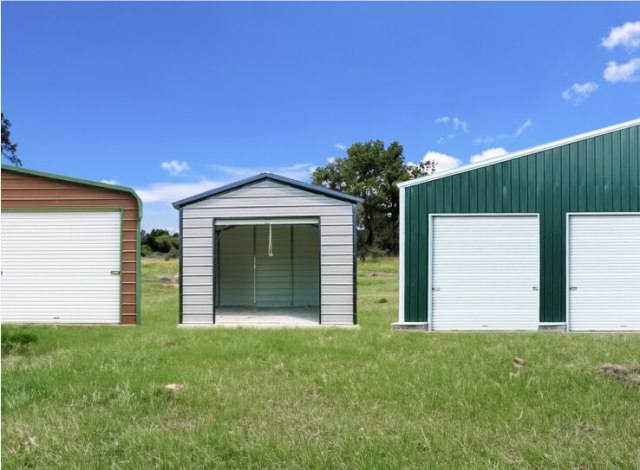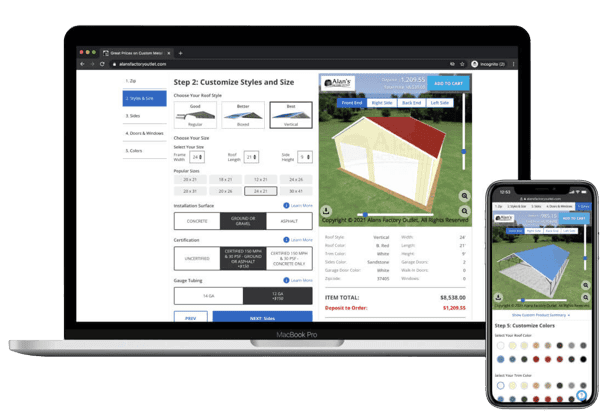Choosing the right metal building size can be tricky. Whether you’re building a workshop, a man cave, or a storefront for your business, you want to avoid ending up with a building that’s too small or too big.
This guide walks you through the most common metal building sizes so you can find the perfect fit for your needs. We’ll also cover the benefits of steel buildings and some key factors to help you choose the right size.
Common Standard Dimensions of Metal Buildings
Did you know that metal buildings come in 64 common standard dimensions? They range from small 50-square-foot sheds to massive 6,000-square-foot barns that can handle extreme weather conditions.
These standard sizes make it easier to find the right building for your needs and budget. Plus, it helps reduce costs since manufacturers like us can streamline production.
But what are those sizes?
To make things easier to follow, we’ve divided the sizes into four categories:
- Metal Sheds
- Small Metal Buildings
- Medium Metal Buildings
- Large Metal Buildings
Standard Metal Shed Sizes (50–300 Sq. Ft.)
Metal sheds are popular for backyard storage, workshops, and hobby areas. They come in several sizes, usually seven to 12 feet wide and seven to 24 feet long.

Here’s a quick overview of the standard shed sizes:
| Size | Size Range (sq ft) |
|---|---|
| Small | 50 – 100 |
| Medium | 100 – 150 |
| Large | 150 – 300 |
Small Shed (50–100 Sq. Ft.)
A small shed is perfect for storing gardening tools, lawn equipment, or firewood. You can also use it as a small workshop or hobby space.
Small sheds come in three sizes:
| No | Size | Width (ft) | Length (ft) | Floor Area (sq ft) |
|---|---|---|---|---|
| 1 | 7×7 | 7 | 7 | 49 |
| 2 | 8×8 | 8 | 8 | 64 |
| 3 | 8×15 | 8 | 10 | 80 |
Medium Shed (100–150 Sq. Ft.)
If you need more space, a medium shed can accommodate a motorcycle, a riding lawnmower, or larger gardening equipment. Medium sheds are also great for a home office or a small guest room.
| No | Size | Width (ft) | Length (ft) | Floor Area (sq ft) |
|---|---|---|---|---|
| 4 | 8×16 | 8 | 16 | 128 |
| 5 | 12×12 | 12 | 12 | 144 |
| 6 | 10×15 | 10 | 15 | 150 |
Large Shed (150–300 Sq. Ft.)
A large shed can store larger items like a tractor, ATV, or boat. You can also use it as a workshop, a home gym, or a small business space. Large, 12×24 sheds can even become tiny homes.
| No | Size | Width (ft) | Length (ft) | Floor Area (sq ft) |
|---|---|---|---|---|
| 7 | 10×16 | 10 | 16 | 160 |
| 8 | 12×16 | 12 | 16 | 192 |
| 9 | 12×24 | 12 | 24 | 288 |
Other Small Metal Buildings Sizes (under 1,000 sq. ft.)
This category includes a wide range of steel structure buildings with floor areas under 1,000 sq. ft.
These buildings range from 12 to 28 feet wide and 20 to 35 feet long.
Our one- and two-car metal garages and carports fall into this category. The larger sizes offer covered parking and extra storage space. These smaller metal buildings are also great for workshops and hobby areas.
Plus, they’re very affordable and quick to construct.
We offer 38 standard sizes in this category, each with unique uses. For example, the 24×24 prefab building is our recommended two-car garage.

The 24×40 with 16-foot legs is great for a fifth-wheel trailer or as a multi-purpose garage.
| No. | Size | Width (ft) | Length (ft) | Floor Area (sq ft) |
|---|---|---|---|---|
| 10 | 12×20 | 12 | 20 | 240 |
| 11 | 12×25 | 12 | 25 | 300 |
| 12 | 12×30 | 12 | 30 | 360 |
| 13 | 18×20 | 18 | 20 | 360 |
| 14 | 20×20 | 20 | 20 | 400 |
| 15 | 12×35 | 12 | 35 | 420 |
| 16 | 20×22 | 20 | 22 | 440 |
| 17 | 22×20 | 22 | 20 | 440 |
| 18 | 18×25 | 18 | 25 | 450 |
| 19 | 20×24 | 20 | 24 | 480 |
| 20 | 24×20 | 24 | 20 | 480 |
| 21 | 22×22 | 22 | 22 | 484 |
| 22 | 20×25 | 20 | 25 | 500 |
| 23 | 26×20 | 26 | 20 | 520 |
| 24 | 18×30 | 18 | 30 | 540 |
| 25 | 22×25 | 22 | 25 | 550 |
| 26 | 28×20 | 28 | 20 | 560 |
| 27 | 24×24 | 24 | 24 | 576 |
| 28 | 20×30 | 20 | 30 | 600 |
| 29 | 24×25 | 24 | 25 | 600 |
| 30 | 30×20 | 30 | 20 | 600 |
| 31 | 18×35 | 18 | 35 | 630 |
| 32 | 26×25 | 26 | 25 | 650 |
| 33 | 22×30 | 22 | 30 | 660 |
| 34 | 20×35 | 20 | 35 | 700 |
| 35 | 28×25 | 28 | 25 | 700 |
| 36 | 32×22 | 32 | 22 | 704 |
| 37 | 24×30 | 24 | 30 | 720 |
| 38 | 30×25 | 30 | 25 | 750 |
| 39 | 22×35 | 22 | 35 | 770 |
| 40 | 26×30 | 26 | 30 | 780 |
| 41 | 20×40 | 20 | 40 | 800 |
| 42 | 24×35 | 24 | 35 | 840 |
| 43 | 28×30 | 28 | 30 | 840 |
| 44 | 30×30 | 30 | 30 | 900 |
| 45 | 26×35 | 26 | 35 | 910 |
| 46 | 24×40 | 24 | 40 | 960 |
| 47 | 28×35 | 28 | 35 | 980 |
Medium Metal Building Sizes (1,000 – 2,500 Sq. Ft.)
Medium-sized metal buildings are incredibly versatile. These larger structures are popular for homeowners who need extra space and small business owners looking to expand. They’re also ideal for multi-car garages and commercial spaces.
Common sizes range from 20 to 40 feet wide and 35 to 60 feet long, with sidewall heights of 12 to 16 feet.
Our larger three- to six-car garages, including RV garages and carports, fall within this size range.

Here are some common uses for medium-sized metal buildings based on their square footage:
| Size Range (sq ft) | Possible Uses |
|---|---|
| 1,000 – 1,500 | Large 3–6-car garage, RV garage, workshop, hobby shop, large home gym. |
| 1,500 – 2,000 | Small business (retail space, salon, etc.), two-car garage with workshop area, farm outbuilding, auto shop, small inventory storage building, one-story office building. |
| 2,000 – 2,500 | Large commercial workshop with storage, commercial gym, guest house, event venue, light industrial manufacturing or storage, mid-sized family home, machine shop, medium inventory warehouse. |
The table below lists ten standard sizes for medium metal buildings.
| No. | Size | Width (ft) | Length (ft) | Floor Area (sq ft) |
|---|---|---|---|---|
| 48 | 20×50 | 20 | 50 | 1,000 |
| 49 | 30×35 | 30 | 35 | 1,050 |
| 50 | 24×45 | 24 | 45 | 1,080 |
| 51 | 24×48 | 24 | 48 | 1,152 |
| 52 | 20×60 | 20 | 60 | 1,200 |
| 53 | 30×40 | 30 | 40 | 1,200 |
| 54 | 30×50 | 30 | 50 | 1,500 |
| 55 | 30×60 | 30 | 60 | 1,800 |
| 56 | 40×50 | 40 | 50 | 2,000 |
| 57 | 40×60 | 40 | 60 | 2,400 |
Large Metal Building Sizes (2,500 Sq. Ft. And Over)
For those needing ample space, large metal buildings offer enough room for many applications. These metal structures offer 2,500 to 6,000 sq. ft. of pure, uninterrupted space, making them the perfect solution for anything from industrial facilities to large commercial metal buildings.

Here are just a few examples of what you could do with a large metal building:
- Storage barns for farm equipment or inventory
- Large truck garages or workshops
- Spacious retail stores or restaurants
- Multi-unit residential apartments
- Large office spaces or fitness centers
- Small manufacturing facilities
The table below lists the standard dimensions of large metal buildings.
| No. | Size | Width (ft) | Length (ft) | Floor Area (sq ft) |
|---|---|---|---|---|
| 58 | 50×50 | 50 | 50 | 2,500 |
| 59 | 40×80 | 40 | 80 | 3,200 |
| 60 | 60×60 | 60 | 60 | 3,600 |
| 61 | 50×80 | 50 | 80 | 4,000 |
| 62 | 60×80 | 60 | 80 | 4,800 |
| 63 | 50×100 | 50 | 100 | 5,000 |
| 64 | 60×100 | 60 | 100 | 6,000 |
Benefits of Steel Buildings
According to Research and Markets, the U.S. pre-engineered Metal Building Market is set to grow at a CAGR of 8.4%. That means by 2030, the market will be worth a whopping $21 billion.
Studies clearly show the benefits of these buildings.

Here’s a breakdown of why people are choosing steel buildings over traditional construction:
Durability and Strength
Steel buildings are built to last. They can withstand tough weather conditions, including heavy snow loads, seismic activity, and strong winds. You can get them rated and certified to withstand 150 mph winds and 35 pounds per square foot of snow.
Steel and iron buildings are also resistant to pests, fire, and rot, so they last for decades with minimal maintenance.
Cost-Effectiveness
Steel buildings are often more affordable than traditional construction. They offer short build times, reducing labor costs. Plus, they offer excellent energy efficiency, which lowers utility bills.
Construction Efficiency
Steel buildings are typically pre-engineered. This means the components are manufactured off-site as a metal building kit and assembled on your property. This streamlined process means your building is ready for work fast.
New Metal Building Size Considerations
How do you choose the perfect size for your build? Here are some key factors to think about.
Intended Use
How you plan to use your building will affect the size and dimensions you need.
- Storage: If you’ll use the building for storage, think about what you’ll be storing and how much space you’ll need. Will you need more floor space, or can you use vertical space?
- Garage or carport: The number, type, and size of vehicles you need to park will determine the size of your carport or garage, its height, and doors.
- Workshop: If you’re setting up a workshop, consider the type of work you’ll be doing. A small woodworking hobby shop might only require a 12×20 foot building, while a larger metalworking shop could need something closer to 30×40 feet.
- Business: The size of your business dictates the size of your building. A small retail store might be comfortable in a 20×30 foot space, while a business with inventory storage might need more space.
Building Codes and Regulations
Local building codes may limit the maximum size of a metal building or have setback requirements that limit how wide or long you can make them. Or, you may just need a permit to install a garage.
Budget and Cost Implications of Metal Building
Your budget will also play a role in determining the size of your building.
Here are a few ways to keep costs down:
- Minimize Height: The taller your building, the more expensive it will be.
- Enclosed vs. Unenclosed: Fully enclosed buildings are usually more expensive than partially enclosed or open structures like carports.
- Standard Sizes: Sticking with standard building sizes can often save you money compared to custom sizes.
Floor area, height, and customization options like doors and windows all contribute to the final price.
At Alan’s Factory Outlet, we offer a wide range of customization options to help you personalize your building for your specific needs and budget.
Ready to Build Your Dream Metal Building?
The size of your metal building impacts construction times, costs, and what you can do with it. Prefab metal buildings of standard sizes are generally at the lower end of metal building prices. By considering your intended use, local regulations, storage needs, and budget, you can find the perfect building to meet your needs.
At Alan’s Factory Outlet, we offer many metal building sizes and styles as well as a range of financing options to accommodate your budget.
Contact us today to get started!
FAQs About Metal Building Sizes
In case you still have some questions in mind, here are answers to some frequently asked questions about metal building sizes:
What Are the Most Common Metal Building Sizes?
The most popular sizes among our customers are:
| Size | Popular Dimensions | Common Use |
|---|---|---|
| Medium | 20′ x 30′ 30’ x 30’ 30′ x 40′ | 2-car garage, larger workshops, and hobby areas. |
| Medium to large | 40′ x 40′ 40’ x 60’ 40’ x 80’ 60′ x 80′ | 3-car garage, small businesses, and agricultural buildings. |
These sizes offer a good balance of space and affordability, making them a popular choice for a variety of needs.
What Are the Most Economical Metal Building Sizes?
Generally, the most economical metal buildings are within standard building size ranges, such as 40’x60’, depending on the application. These sizes are pre-engineered steel buildings produced in larger quantities, which helps keep the construction project’s costs down.
With modular frames and limited interior supports, larger buildings up to 480’ wide are possible. These structures offer broad, unobstructed spans at a more economical cost.
Smaller metal buildings, like 20’x30’ sheds and 30’x40’ workshops and barns with simple designs and smaller steel framing, are more cost-effective. If you don’t need much space or customization, a smaller building can be a great way to save money.
Is the Height of the Metal Buildings Customizable?
Yes, the height of our metal buildings is customizable. To see how it’s important to understand a few key concepts:
- Leg height or the height of the sidewalls: You can typically choose a leg height between six and 16 feet.
- The roof’s Peak height depends on the leg height, roof style, and building width.
- Center clearance or the highest possible vertical clearance at the center of the building: The center clearance is affected by the leg height, roof style, and building width.

You can use the clearance calculator to find out exactly what leg height you need for your application.




